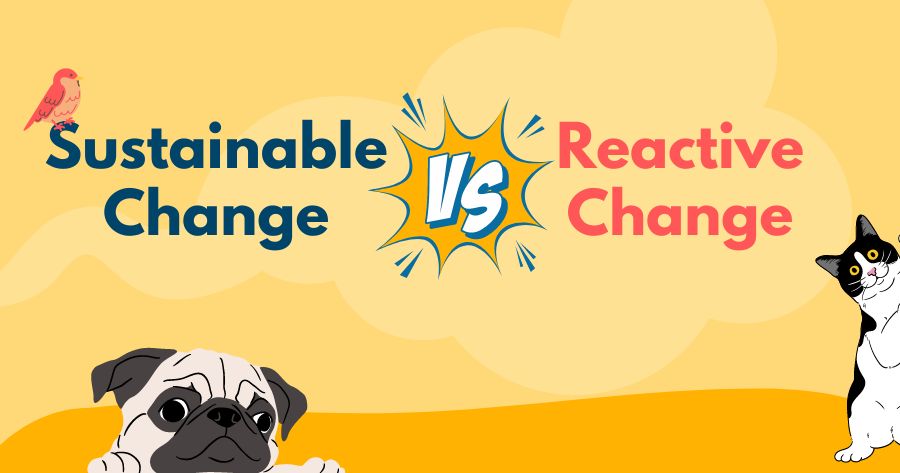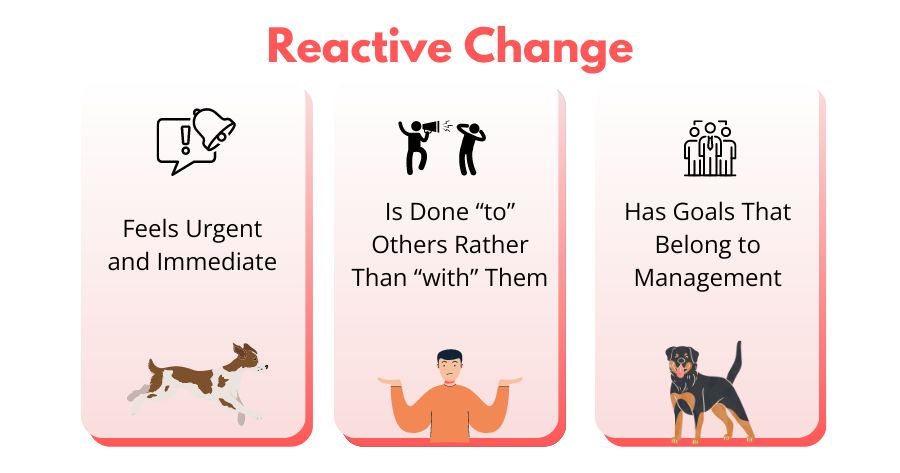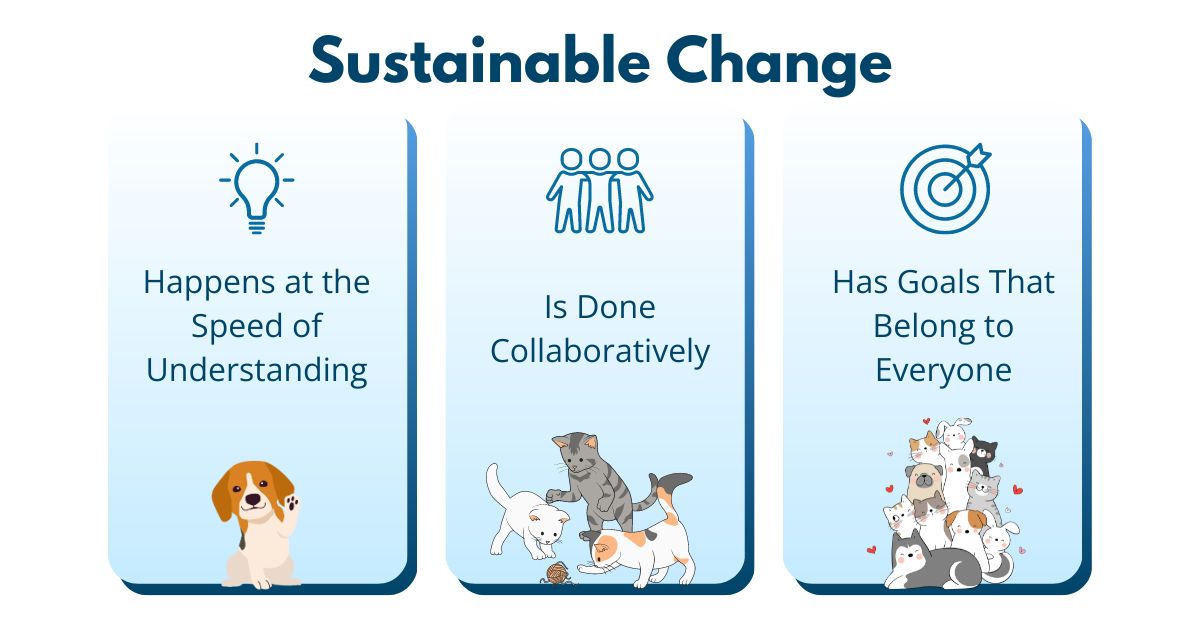Creating change in a veterinary practice is hard, time-consuming, and slow. Teams can be resistant to change, stuck in their ways, and comfortable with the status quo. As a leader in your practice, you may be able to force change through willpower alone, but relatively quickly your team will return to their previous habits or patterns.
Two Kinds of Change: Reactive and Sustainable
It’s exhausting for leaders to work to create change – only to expend energy all over again because the change didn’t last. To avoid it, and create change that lasts, it’s important to recognize the differences between reactive and sustainable change.

Reactive change is simply people using willpower to change because they feel like they should, have a short-term incentive, or are avoiding pain or consequences. As soon as the stimulus or threat is removed, they return to their regular habits or patterns.
Sustainable change happens when people have a desire to achieve a new end state and develop the habits and patterns that help them do that. Let’s review the key differences between reactive and sustainable change.
Reactive Change
Change is about choices and learning, and usually, those things don’t happen instantly. If someone shows up to work drastically different one day because someone told them to, don’t expect it to last. That’s not because they don’t have good intentions, but because real change takes time.
Reactive Change Feels Urgent and Immediate
What if you had to drive a stick shift immediately and you had never done it before? What if you had to immediately start asking better and more frequent questions as a manager coaching others? Most people can’t decide, learn, process, and create new habits that quickly. When you light a fire under people to cause change, you simply settle for reactive change that won’t last.
Reactive Change is Done “to” Others Rather Than “with” Them

If change feels like it’s directed, enforced, or “handed down,” then it probably won’t be sustainable. In this situation, management becomes the enforcer, and that’s never a viable, long-term solution. Even if managers can keep people in line with the new way of doing things, they crush engagement in the process. Then, the business erodes as a result of a poor culture.
No one wants to work in that type of environment; even the managers usually hate feeling like a prison guard much of the time. No one is focusing on growth in this kind of business, and the team is simply trying not to get caught breaking the rules. Welcome to the kind of place the best performers leave as quickly as they can.
The goals of Reactive Change Belong to Management
Sometimes management decides a change is necessary and attempts to sell it to the team by saying it’s a good thing for them. This is often followed by giving the team instructions on how to implement the change. But ask yourself, when was the last time you made a real difference to anything just because someone else thought you should, even as you didn’t agree, didn’t understand, or weren’t sure about where you were headed or why?
Sustainable Change
If you want sustainable change, even if it is handed down from above, allow the team to figure out how to enact the change, talk candidly about the challenges, and work their way through them. Most people don’t want to lead a revolution against change if it seems to be well-intentioned. They just need to figure out how to make it work for them.
Sustainable Change Happens at the Speed of Understanding
Teams are allowed time to process and understand the change. Change has to be understood before people can decide on whether or not they agree with it. Individuals need to think about the challenges, the mechanics of doing things differently, and the risks and benefits associated with the change.
Sustainable Change is Done Collaboratively

The most lasting change happens with involvement, not just compliance. People readily make changes for things in which they are involved. It’s the difference between your spouse picking your new car out - even if you have never talked about what kind of new car you wanted - and going shopping together for the right one.
If you are expecting a team to essentially live in a new world where they do things differently, allow them to help design the space and contribute to the change, not just live in a world someone else created. When we are involved in change, it becomes our change, not someone else’s.
The Goals of Sustainable Change Belong to Everyone
Consider this: If I were to ask a member of a team involved in reactive change why they are changing, the answer is usually something like, “Management told us to.” In contrast, when I ask someone involved in sustainable change why they are changing, the answer is completely different. It's more like “we think this will help us be more efficient and provide better service.”
Which person is more committed to doing things to make the change happen in a sustainable way? It’s very easy to know if your team shares the goals of the modification with management or not. Just ask them what the goals are and why they’re important to them. If it doesn’t matter, it won’t be sustainable.
Changing the Destination in Your Veterinary Practice

Change is challenging, even when we want it and have a good plan to make it happen. It’s nearly impossible when someone else wants it for us. We might even go along with it begrudgingly in an attempt to stay out of trouble. If we want the future of the hospital to be different, our team needs to commit to sustainable change.
If we find ourselves enforcing, policing, punishing, or fighting resistance, we’ve done something wrong in the change process. Now we are now the proud owners of reactive, unsustainable change that is only temporary. The good news is if we alter the roadmap for change, we can reach an entirely different destination.
Ready to create sustainable change in your practice?
Start with a free 7-day trial membership to VetLead and get the resources you need to drive lasting change.
How has change happened in your veterinary practice? Share you stories with your colleagues in the comments below.